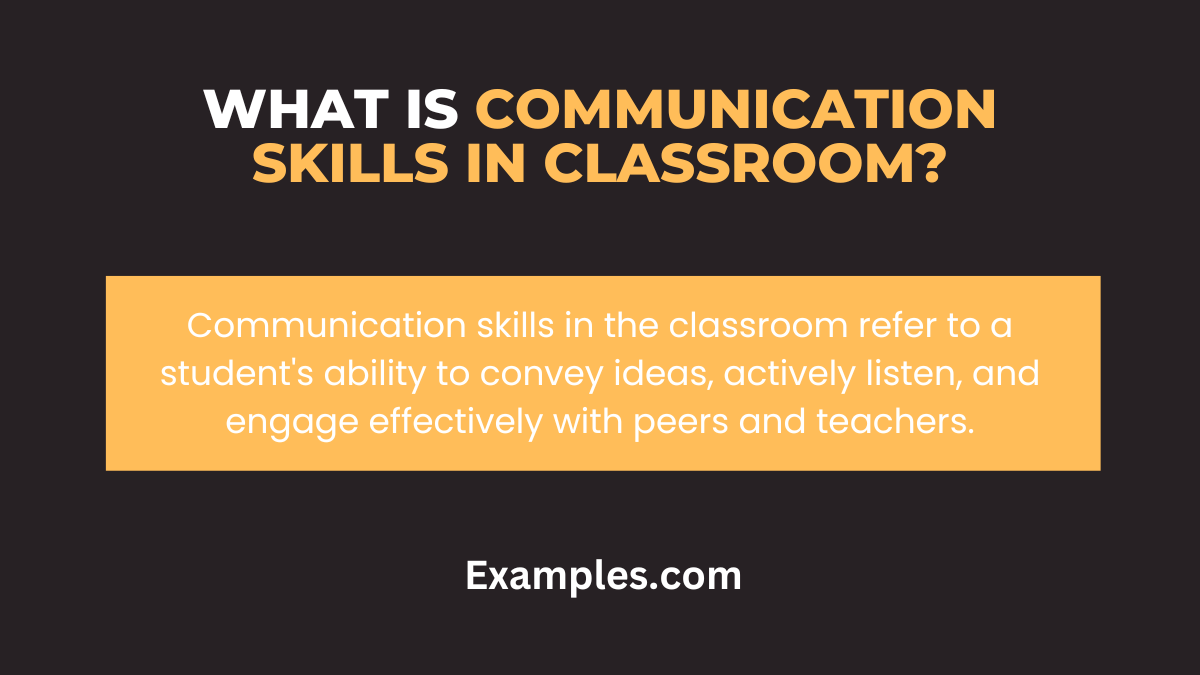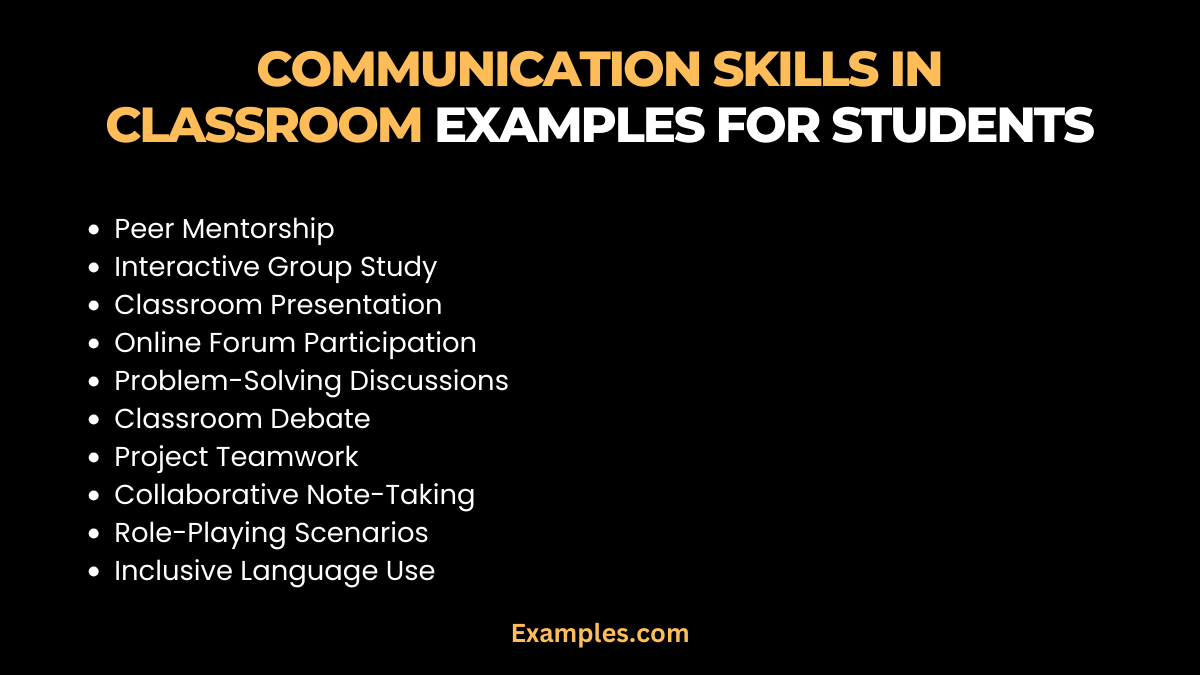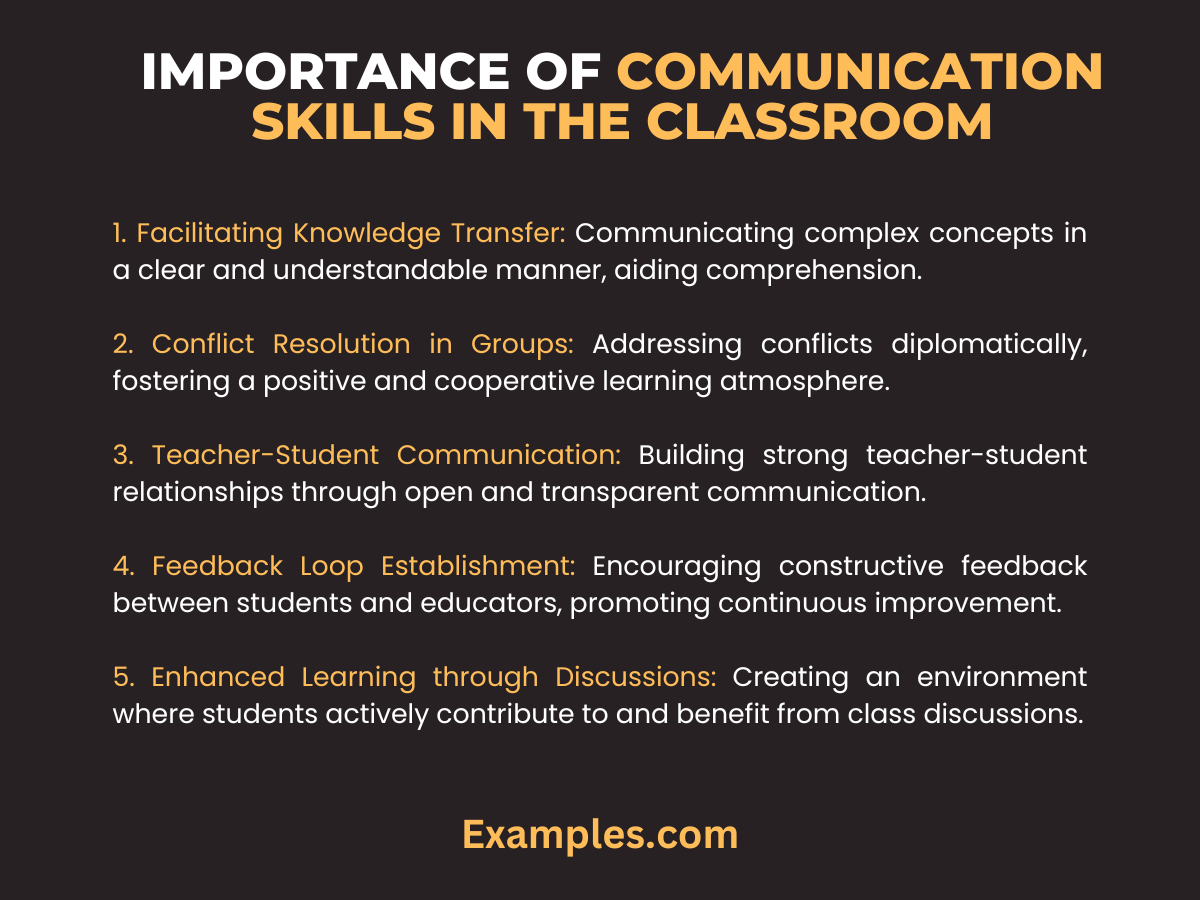29+ Communication Skills in Classroom Examples
Enhance the educational journey with our comprehensive guide on Communication Skills in Classroom. This detailed exploration not only delves into the importance of effective communication in academic settings but also provides actionable strategies for improvement. Discover the transformative power of Communication Examples as we navigate through practical tips, empowering students to excel in interpersonal dynamics within the classroom environment. Elevate the learning experience through the lens of clear and impactful communication
What is Communication Skills in Classroom?

Communication Skills in the classroom refer to the ability of students to convey and receive messages effectively. In simple terms, it involves expressing ideas clearly, listening attentively, and fostering a positive exchange of information. These skills are crucial for academic success, as they contribute to a conducive learning environment. Understanding the essence of Communication Skills in the Classroom sets the foundation for improved interactions, collaboration, and overall academic achievement.
What is the best Example of Communication Skills in Classroom?
One standout example of effective Communication Skills in the classroom is the practice of collaborative learning activities. Students engage in group discussions, projects, and presentations, fostering verbal and interpersonal communication. This not only enhances their ability to express thoughts clearly but also cultivates active listening and understanding diverse perspectives. Through this example, students develop vital skills that extend beyond the classroom, preparing them for successful communication in various personal and professional settings.
30 Communication Skills in Classroom Examples
Explore a rich array of 30 Communication Skills in Classroom Examples, each offering a unique perspective on fostering effective student communication. From verbal articulation to nonverbal cues, this compilation provides a diverse showcase of skills crucial for academic success.
- Active Listening: Engaging attentively in class discussions, nodding to show understanding.
- Clear Articulation: Expressing ideas with precision, ensuring clarity in communication.
- Peer Collaboration: Working together on group projects, enhancing interpersonal skills.
- Constructive Feedback: Offering helpful insights during peer reviews, promoting growth.
- Public Speaking: Delivering presentations confidently, capturing the audience’s attention.
- Empathy Display: Understanding classmates’ perspectives, showing empathy in discussions.
- Nonverbal Awareness: Utilizing positive body language, enhancing overall communication.
- Conflict Resolution: Addressing disagreements diplomatically, fostering a positive class environment.
- Written Communication: Crafting concise and effective written responses to assignments.
- Questioning Skills: Asking thoughtful questions to promote discussion and critical thinking.
- Collaborative Projects: Contributing ideas and effort to group projects, fostering teamwork.
- Digital Communication Etiquette: Using email and online platforms professionally in academic settings.
- Art of Compromise: Finding common ground during group decision-making processes.
- Time Management Communication: Effectively communicating about project timelines and deadlines.
- Feedback Reception: Accepting constructive criticism positively, demonstrating growth mindset.
- Class Participation: Actively engaging in class discussions, contributing valuable insights.
- Conflict De-escalation: Calmly resolving conflicts among peers to maintain a positive atmosphere.
- Visual Aids Utilization: Enhancing presentations with visual elements for better understanding.
- Peer Teaching: Explaining concepts to classmates, reinforcing personal understanding.
- Cultural Sensitivity: Being aware of and respecting cultural differences during interactions.
- Active Reading Strategies: Discussing reading materials thoughtfully, encouraging class participation.
- Group Decision-Making: Collaboratively making decisions as a team, ensuring inclusivity.
- Note-Taking Skills: Developing effective note-taking methods for improved understanding.
- Verbal Expression of Gratitude: Acknowledging and appreciating contributions from classmates.
- Mindful Communication: Being present and focused during class discussions, avoiding distractions.
- Use of Technology for Communication: Leveraging digital tools for effective communication within the class.
- Debating Skills: Engaging in respectful debates, presenting and defending viewpoints eloquently.
- Presentation Structure: Organizing ideas logically in presentations for enhanced comprehension.
- Conflict Mediation: Assisting peers in resolving conflicts, acting as a mediator when needed.
- Reflective Communication: Thoughtfully reflecting on personal learning experiences, sharing insights with the class.
Communication Skills in Classroom Examples for Students:

Discover impactful communication skills in the classroom designed specifically for students. This curated collection focuses on fostering effective interaction, from active listening to collaborative project management, equipping students with essential skills for academic success.
- Peer Mentorship: Senior students guiding freshmen through academic challenges, ensuring a smooth transition.
- Interactive Group Study: Collaborating with classmates to share insights and reinforce understanding.
- Classroom Presentation: Effectively communicating ideas through well-structured and engaging presentations.
- Online Forum Participation: Contributing thoughtfully to virtual discussions, showcasing digital communication skills.
- Problem-Solving Discussions: Collaboratively addressing complex problems, encouraging critical thinking.
- Classroom Debate: Engaging in respectful debates, honing persuasive communication skills.
- Project Teamwork: Working harmoniously in teams, combining diverse skills for successful project completion.
- Collaborative Note-Taking: Sharing and comparing notes with peers for a comprehensive understanding.
- Role-Playing Scenarios: Practicing communication skills through role-play, improving real-life interactions.
- Inclusive Language Use: Choosing words that promote inclusivity, creating a welcoming classroom atmosphere.
Communication Skills in Classroom Examples for Performance Review:
Navigate the nuances of communication skills in the classroom tailored for performance evaluations. This compilation focuses on interactions that contribute to a positive academic environment and demonstrate a student’s growth and engagement.
- Effective Feedback Reception: Acknowledging constructive criticism positively, showcasing a commitment to improvement.
- Leadership in Group Projects: Guiding and motivating team members, contributing to project success.
- Initiative in Class Discussions: Taking the lead in discussions, displaying proactive engagement with course material.
- Collaborative Problem-Solving: Contributing innovative solutions during collaborative problem-solving activities.
- Timely and Clear Communication: Effectively communicating project updates and deadlines, ensuring team alignment.
- Consistent Class Participation: Actively engaging in class discussions, demonstrating sustained interest and involvement.
- Adaptability in Group Settings: Demonstrating flexibility and adaptability during teamwork and group assignments.
- Positive Peer Interactions: Building positive relationships with classmates, contributing to a harmonious classroom environment.
- Reflection on Personal Growth: Articulating personal and academic growth through effective self-reflection.
- Contribution to a Positive Classroom Culture: Fostering a supportive and inclusive classroom culture through communication and collaboration.
Importance of Communication Skills in the Classroom:

Uncover the significance of communication skills in the classroom, where effective communication lays the foundation for a conducive learning environment. This exploration emphasizes the role of communication in academic success and personal development.
- Facilitating Knowledge Transfer: Communicating complex concepts in a clear and understandable manner, aiding comprehension.
- Conflict Resolution in Groups: Addressing conflicts diplomatically, fostering a positive and cooperative learning atmosphere.
- Teacher-Student Communication: Building strong teacher-student relationships through open and transparent communication.
- Feedback Loop Establishment: Encouraging constructive feedback between students and educators, promoting continuous improvement.
- Enhanced Learning through Discussions: Creating an environment where students actively contribute to and benefit from class discussions.
- Effective Communication with Parents: Establishing clear channels of communication to keep parents informed and engaged.
- Peer Support Networks: Encouraging students to communicate and support each other academically and personally.
- Preparation for Professional Settings: Developing communication skills that are essential for future professional success.
- Empowering Student Leadership: Fostering communication skills that enable students to take leadership roles in various academic endeavors.
- Incorporating Diverse Perspectives: Creating an inclusive classroom where diverse perspectives are valued and communicated effectively.
Strategies to Improve Communication Skills in the Classroom
In the pursuit of fostering effective communication, implementing targeted strategies is paramount. Explore a comprehensive guide on enhancing communication skills within the classroom setting, encompassing diverse approaches that cater to various learning styles and preferences.
- Active Listening Techniques: Engage students in activities that promote active listening, such as summarizing discussions or participating in reflective exercises. This cultivates a habit of attentiveness and improves overall comprehension.
- Interactive Group Projects: Foster collaboration through group projects that require students to communicate, delegate tasks, and present findings. This not only hones communication skills but also encourages teamwork and creativity.
- Role-Playing Scenarios: Introduce role-playing exercises that simulate real-world communication scenarios. This hands-on approach allows students to practice different communication styles and adaptability.
- Feedback Workshops: Organize regular feedback sessions where students provide constructive critiques to peers. This creates a culture of openness and continuous improvement in communication.
- Technology Integration: Incorporate digital tools and platforms for communication, preparing students for modern workplace dynamics. Emphasize email etiquette, online discussions, and collaborative document editing.
- Public Speaking Opportunities: Create a supportive environment for public speaking, encouraging students to express ideas confidently. Provide constructive feedback to boost self-assurance and refine presentation skills.
- Cross-Cultural Communication Exercises: Design activities that expose students to diverse communication styles, fostering an appreciation for cultural nuances. This helps develop adaptability and intercultural communication skills.
- Classroom Debates: Organize structured debates on relevant topics, promoting critical thinking and articulate expression of viewpoints. This enhances persuasive communication skills and the ability to construct coherent arguments.
- Effective Use of Visual Aids: Train students in utilizing visual aids to enhance their verbal communication. This includes creating engaging presentations with clear visuals that complement spoken content.
- Encourage Questioning and Discussion: Cultivate a classroom culture where students feel comfortable asking questions and engaging in discussions. This not only improves verbal communication but also enhances critical thinking.
How do Students Enhance their Communication Skills in the Classroom?
Understanding the specific actions students can take to improve their communication skills is pivotal for personal development. Delve into this comprehensive guide on empowering students to actively enhance their communication prowess within the classroom environment.
- Self-Assessment and Reflection: Encourage students to assess their communication strengths and areas for improvement. Reflection journals and self-assessment exercises promote self-awareness and accountability.
- Active Participation in Class Discussions: Actively engaging in class discussions provides students with regular opportunities to articulate their thoughts and ideas. This fosters confidence and enhances verbal communication skills.
- Seeking Constructive Feedback: Promote a culture of seeking and providing constructive feedback among students. This exchange facilitates continuous improvement and refinement of communication abilities.
- Utilizing Resources for Improvement: Direct students to resources, workshops, or online courses that focus on communication skills. This external guidance complements classroom learning and offers additional insights.
- Joining Communication-focused Clubs or Activities: Encourage participation in clubs or activities that specifically target communication skills. Debate clubs, public speaking events, or drama clubs can provide valuable platforms for skill development.
- Collaborative Learning Initiatives: Engage in collaborative learning initiatives, where students work together on projects or presentations. This enhances not only communication skills but also teamwork and interpersonal dynamics.
- Active Listening Practices: Stress the importance of active listening as a foundational communication skill. Provide exercises that train students to listen attentively, paraphrase information, and ask clarifying questions.
- Time Management in Group Projects: Emphasize the significance of effective communication in managing group projects. Setting timelines, regular updates, and clear delegation of tasks contribute to successful teamwork.
- Utilizing Technology for Communication: Familiarize students with various communication tools and platforms. This includes email etiquette, virtual meetings, and collaborative document editing, preparing them for digital communication in professional settings.
- Networking Opportunities: Provide networking opportunities within and outside the classroom. Interacting with peers, faculty, and professionals hones communication skills in diverse social contexts.
In conclusion, mastering communication skills in the classroom is pivotal for academic success and personal development. This guide has equipped you with practical strategies, insightful tips, and actionable steps to enhance your abilities. Embrace active listening, engage in collaborative learning, and employ diverse communication techniques. Elevate your classroom experience by fostering effective communication for a brighter academic journey.


